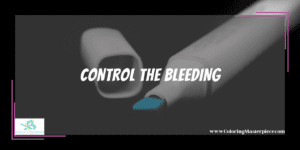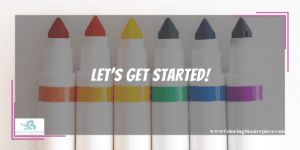If you’ve used Copic markers, you know they are worth paying a little extra for the quality. The great thing about these markers is the ability to change out the tips and refill the ink. So now you want to use these markers on fabric, but will they be permanent?
If you would like to use Copic markers on fabric, there are some important strategies to remember. Let’s take a look at what you should be aware of before putting markers on fabric.
Control the Bleeding

The most important part of using Copic markers on fabric is to control the bleeding. All markers bleed ink into the fabric, which can ruin a project quickly if certain guidelines aren’t followed. Before picking up your markers, place a piece of cardboard or cardstock beneath the fabric. This keeps ink from bleeding through the fabric onto your work surface and from bleeding onto other areas of the fabric you don’t want to be colored.
Once you’re reading to begin coloring, keep the following things in mind:
Use light pressure
The harder you press the marker onto the fabric, the more the ink will bleed. Using light pressure allows you to add more ink a little at a time until you get the coverage and look you want in the area you are coloring. It’s nearly impossible to fix a mistake caused by alcohol-based ink. Apply the color slowly, especially when you are first starting.
Do not color in a circular motion
We know that coloring in a circular motion provides clear, thorough coverage of color. But, when using markers on fabric, coloring in a circular motion will lay down more ink than the fabric can handle, ruining your project and causing a lot of bleeding. Depending on the fragility of the fabric, hard pressure may cause the threading to shred. The best way to apply the ink is to use a flicking motion with the tip against the fabric.
Start from the inside and move out
Once you pick the area you want to begin coloring, start from inside the area and color toward the borderline. Coloring in this way allows you better control over the ink bleeding toward the border to keep from coloring outside the lines.
Do not color right up against the borderline
If you color up against the border outline of the drawing, you risk bleeding ink over the outline of the area being colored. Like coloring outside the lines in a coloring book. It’s important to slowly color as you approach the border, leaving an uncolored space between the ink and the borderline.
More Copic Marker Tips HERE!
Choosing Fabric
The type of fabric you choose will impact how the markers perform. All fabrics have a weave. The weave may be tight like cotton or loose like muslin and impacts the extent the ink bleeds in the fabric. If you choose a loose weave fabric, it may cause difficulty when coloring with a small tip marker.
Let’s take a look at common fabrics used with Copic markers:
Cotton
Cotton is an obvious fabric choice. Projects for creating dish towels, t-shirts, and decorative pillowcases are endless. With a tight weave and durability, you can practice using markers with cotton fabric over and over again. If you are a beginner, a great inexpensive way to practice is by purchasing fabric scraps at your local arts and crafts store.
Polyester
Polyester fabric is very durable and feels more rough than cotton fabric. A strong texture in the fabric can change the look of your picture and make color coverage slightly more difficult. If you can easily feel the texture of the fabric, practice coloring with a marker to understand how the color is going to lay within the weave.
Muslin
Muslin is a thin, loose-weave cotton fabric. Some muslin fabrics have such a loose weave that they resemble gauze. This fabric is more difficult to use with markers because a small tip can get caught up in the threads and the bleeding may be harder to control.
Linen
Linen is a soft fabric. The weave is small and tight, but due to the nature of the fabric, ink may bleed more easily across an area. Linen is a great fabric for creating vintage-looking projects.
Let’s get started!

Armed with the technical information, your fabric, and the colors you chose, it’s time to get creative! But remember, it is best to practice with the markers and fabric a couple of times before diving in on what will be your finished project. Finally, make sure to keep in mind the guidelines discussed above:
- Use light pressure
- Do not color in a circular motion
- Start from the inside and move out
- Do not color right up to the border
Once you’ve completed your picture, it’s important to apply heat to the colored areas of your picture before the first washing. This helps adhere the ink into the fabric, lessening the bleeding and fading of the ink with future washings.
Two ways you can apply heat is by using an iron or putting the fabric in the dryer. If you choose to put the fabric in the dryer, you only need to have it in there on medium heat for a few minutes, until the fabric is almost hot to the touch.
If you choose to apply heat with an iron, make sure to place another piece of fabric over the drawing to avoid damaging it. Using a medium-heat setting, iron over the picture a handful of times, then remove the protective fabric you placed over the picture and let your project cool.
It can take some time to learn how to work with and control the ink bleeding but have fun practicing. Don’t be afraid to use different textures, colors, and thicknesses of the fabric when exploring using markers on fabric, you never know what you can create!
Ready to start your coloring masterpiece? Download my free adult coloring eBook and sign up for my email newsletter HERE!
Disclaimer: The information provided by ColoringMasterpiece.com (“The Site”) is for general informational purposes only. All information on the Site is provided in good faith, however, we make no representation or warranty of any kind, express or implied, regarding the accuracy, adequacy, validity, reliability, availability, or completeness of any information on the Site. Under no circumstance shall we have any liability to you for any loss or damage of any kind incurred as a result of the use of the Site or Reliance on any information provided on the Site. Your use of the Site and your reliance on any information on the Site is solely at your own risk. This blog post is for educational purposes only and does not constitute legal advice. Please consult a legal expert to address your specific needs.
Terms and Conditions: https://coloringmasterpiece.com/terms-and-conditions/
